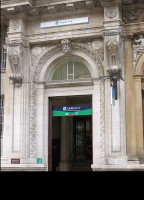 Entrance to the West of England and South Wales District Bank building.
Entrance to the West of England and South Wales District Bank building.
In Corn Street, Bristol, stands a Victorian building decorated with an impressive array of architectural sculpture. Now the Llloyds Bank, it was built as the West of England and South Wales District Bank building, completed in 1857. It was built by the obscure architects W. B. Gingell and T. R. Lysaght, designed in Italian Renaissance style based, says the plaque on the building, on Jacopo Sansovino’s Library of St Mark, Venice. Flat fronted on a not particularly wide street and not particularly high, we should note at the outset that it is the sculpture which makes the building, and without it would be just another perfectly fine but not particularly remarkable banking building of the period.
Before looking at this sculpture, a few words on the bank. The West of England and South Wales District Bank had been founded in Bristol in 1834, and grew rapidly enough that by 1854 it was able to buy a tavern on this site, and replace it with this headquarters building, moving in during early 1857. The cost was apparently £40,000, which added to the £10,000 cost of purchasing the inn made it an expensive venture for the bank. 20 years later, it had grown to 42 branches, but in 1878 it collapsed – on its suspension, the New York Times reported that its liabilities were $17.5m and its cash in hand estimated at only $1.25 million, which the Directors ascribed to ‘the drain upon its deposits caused by persistent and often unjustifiable rumours which have been circulated for weeks past’ but which later on, the liquidators ascribed to imprudent lending, largely to Welsh Iron companies. Lloyds Bank have occupied the building since 1892, just a few years after the district bank's collapse.
Now to the sculpture. There is a lot of it: 22 spandrel figures (see this page for other examples of spandrel figures) – 10 above the ground floor windows, 12 above the 1st floor ones. And thus 12 keystones – 5 keystone heads above the ground floor and an extra one above the door, 6 other keystones above the first floor. And above each of the principal floors is a continuous sculpted frieze across the whole breadth of the building.
 Entrance to the West of England and South Wales District Bank building.
Entrance to the West of England and South Wales District Bank building.
We start briefly with the entrance, forming the left hand bay of the ground floor only, and apparently of later date than the rest of the sculpture. The doorway has a stylised leaf design all the way around the rounded arch and the spaces above the arch, that is to say the spandrels – Spandrels 1 and 2 we may call them – are the only ones without figure sculpture, containing swirly leaves and roundels incorporating the street numbers for the building: 53 and 55. The central keystone head shows a bearded man, with oak leaves and cones in his hair. (Lots of pictures of different types of keystones on this page.)
Taking the rest of the ground floor from the left:
The five arched windows following to the right include five keystone heads, all bearded males, which according to the scholarly people at PMSA, represent five river gods, indicated by coats of arms on a frieze running directly above in the entablature, rather tucked under a shelf above. Apparently they are the Taff (for Cardiff), the Exe for Exeter, the Bristol Channel for Bristol itself, thus central, the Avon for Bath, and the Usk for Newport, so covering the areas within the purview of the Bank. The sculptures are not particularly obviously associated with the relevant towns, excepting Cardiff, who has hammers in his hair, beside the point of an anvil, indicating the iron and steel industry. Exeter has a mix of corn and fruit, Bristol has fruit and oak leaves, Bath has what may be quinces or pears, and corn again, and the rim of some crown made of a seashell. Newport has horns, over which a chain hangs.
Now to the ground floor spandrels figures, running from spandrels 3 and 4 to 11 and 12, thus 10 in all. They are all male, muscular and classical, with drapes around their waists and thighs, and their chests and arms bare. The two outermost, nos. 3 and 12, face away from us, the others are all seen frontally, though the nature of spandrel figures means that while the upper body is seen more or less from the front, or three-quarters view, the legs are more towards a profile position. Each figure thus has a twist in the body. According to the PMSA again, they are emblematic of the produce of the chief individual towns and localities served by the Company, but they do not obviously seem to align with the River Gods. From the left again:
The first two (Spandrels 3 and 4) represent Heavy Industry. No. 3, facing away from us, holds a hammer, and behind him are pieces of machinery; a ball and chain, anvil, tongs, a spoked wheel, and something looking like a mangle. His fellow, No. 4, rest a pickaxe on his knee, and behind him are a basket filled with ore, a shovel, and a reference to agriculture with a sheep (more sheep sculpture on this page) and corn. You will need to click on the small pictures to see all these accoutrements.
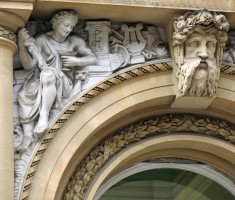
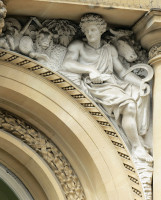 Waters of Aquae Solis, and Agriculture.
Waters of Aquae Solis, and Agriculture.
The next two. Spandrel No. 5 is drinking from a cup, resting his elbow on a spring gushing water from a lion’s head (see this page if you like lion's head sculpture); these are the waters of Bath (Aquae Solis), and the medicinal effects of the waters are indicated by the Aesculapian staff with a snake wound around it. He would seem to be a soldier, as he holds a sword, but the sword is in its scabbard, as he rests and drinks, and the sound of water turns his mind to Music, with a variety of musical instruments next to him – harp, cymbals, pan-pipes, oboe and flute, tambourine. No. 6 is an allegorical figure of Agriculture (a discussion of the type on this page), holding sickle and wool-shears, and next to him is another sheep, and behind, a sheaf of corn and a cow, and agricultural implements.
No. 7 is Trade and Navigation by Sea, holding the prow of a boat and a propeller shaft, with next to him a coiled map, globe and sextant. No. 8 seems to be Mechanical Engineering, with a variety of metal bashing tools.
No. 9 seems to combine metal bashing and trade, with parcels ready for transport by ship (seen behind), a rolled carpet, wreath and sceptre, and anvil and cog wheel. No. 10 also has a combination of accoutrements: an anchor and barrel indicating sea transport, and the sheep, corn and fruit of agriculture. I do not recognise the plunger thing he holds.
No. 11 is Mining, and carries a ladle and a copper ingot, helpfully labelled (we are seeing the forward end of a long ingot designed to be carried over the shoulder by a strong man), casket for holding molten metal, and bowl with ore or slag. Behind is the prow of the ship needed to transport the raw materials and finished goods (for more ship sculpture, including ship prows, see this page). And finally, No. 12, facing away from us, and supremely muscular, is back to Heavy Industry, with hammer, tongs, gearwheel and spade, all of prodigious size and strength, a basket of ore, and a bit of Agriculture with sheep and corn.
So much for the ground floor. Up on the first floor level, there is an extra window, thus above the door on the ground floor, and thus 12 spandrels, all occupied by allegorical spandrel girls. We should first at least briefly note the keystones, which are alternating curly brackets with wreaths, and prows of ships bearing lion’s heads with festoons hanging from their mouths.
Again according to the PMSA, the girls are supposed to represent Justice, Charity, Integrity, Education, Art and Science, but it is not easy to see quite this selection in the accoutrements of the figures, as we shall see. Compositionally, all are facing towards us, and while they all have something of a twist to the legs, in some cases this is slight, so we see both legs, in other cases the upper body is completely facing us, and the legs completely in profile, as in ancient Egyptian art. All, however, are elegant. All are chastely draped, and generally have some sort of headpiece. Once again, we observe them from the left:
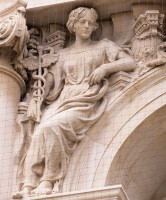 Allegorical figure of Travel and Merchandise.
Allegorical figure of Travel and Merchandise.
Spandrel No. 1 is clearly an allegorical figure of Travel and Merchandise. She carries the Caduceus, the staff of Hermes, messenger of the Gods (Mercury to the Romans), and behind her ocean-going ships, their sales full, travel across the waves. Her drapes across hip and thigh have a swirliness suggestive of a breezy trade wind, and nicely reflect the coils of the snakes on her staff. In her hair she wears a crown of laurel.
No. 2 is just as clearly representative of Agriculture. She carries a sickle and a sheaf of some grain, probably barley. She has a stronger physique, as befits a worker on the land, and her hair is sensibly tied and confined with a wide band of cloth.
No 3. is emblematic of The Arts, holding a palette, an easel behind her other shoulder, with a bust of Athena to represent Sculpture (more allegorical figures of Sculpture on this page), and a Corinthian pillar capital which conventionally represents Architecture (more examples of the breed on this page). Various tools of the trade are in the corner. She wears a crown of leaves.
No. 4 is Mechanics, with a screw press, gearwheel, spoked wheel, what may be a regulator, and two conic solids and scrolls to represent the calculative aspects of this discipline.
No. 5 is Motherhood, or could I suppose be Charity, with two infants, one of whom she is holding, the other feeding, thus succour and sustenance. She wars a cloth head covering. No. 6 continues the theme with a further two infants, and is Education, with books and a lamp, and behind one shoulder, a globe. A band with a diadem is in her hair. (More statues of Education may be seen on this page.)
Number 7 has a heap of books, a sprig of mistletoe, and holds some instrument in her other hand, and is obscure to me. Her companion, No. 8, is Truth (her book is labelled thus - other examples of Truth on this page), and has tied around her a lion’s pelt, indicative of strength or authority. The sprig of oak in her other hand supports this, as the oak is a tower of strength.
No. 9 is seemingly Peace. She carries an olive branch in one hand, a palm leaf in the other, and a dove nestles on one arm; she treads underfoot a helmet, for she has put the trappings of war aside, and also has a sheaf of corn, representing the benefits flowing from Peace.
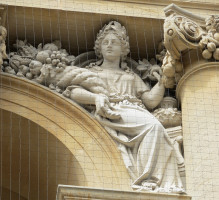 Fruitfulness, with cornucopia.
Fruitfulness, with cornucopia.
Opposite her sits Plenty, or Fruitfulness, who holds a cornucopia, overflowing with rich fruit and corn, a richly decorated bowl by her other arm. She holds a branch bearing small fruits in her other hand.
No. 11 is Navigation, with globe and compasses, set square, clock, sextant and ship’s wheel; a heap of rope is in the background, and a rolled up scroll indicating a map. Number 12 accompanies her as Trade, with wrapped parcels, tied scrolls, and a few heads of corn in her hand. Well, these are my interpretations anyway.
Above all of these allegorical girls is a continuous frieze with putti running the full breadth of the building. Compositionally, it is actually made of 13 separate elements: six groups of four putti or wingless cherubs above each arch, separated by seven repeating cartouches, each borne by the tails of two classical dolphins, and each showing a castle except two, which bear a beehive (Industry), and a crown with the motto ‘defendamus’ [may we protect]. We may note that because the entrance end is separated from the rest of the building with a double pilaster at first floor level rather than a single one, the frieze has two cartouches, borne by fish rather than dolphins. The use of putti on the frieze is both to indicate the lesser importance to the overall design of the building to the floors below, and because the shorter stature conveniently fits in the height available. From the left, the first group is creating artworks, inscribing a pot, painting, writing or designing, and holding a model of a church; on the floor is a bust, so most of the Arts are represented. The second group are trading their decorated pots, a carpet and jewellery for bags of money – the caduceus is again in view as a symbol associated with merchants. The next group are minting and bagging coins, and the fourth group weigh the coins and put them into strongboxes. The penultimate group seem to be printing notes, with a hand-press and large, lumpy hammers to press and dry ink. The final, sixth group are trading again with an Arabian putto in a turban, and an American one with feathered headpiece and bow and arrows, this time their goods being ivory and stuffs in parcels and clay pots. The makers and traders are shown as less civilised than the bankers, by making the former semidraped while the latter are fully clothed.
Which sculptor would have the fortitude to produce such a large number of figures – 22 spandrel figures and 24 cherubs – with so many accoutrements, all to such a high standard of carving? It could only be John Thomas, the most prolific and dedicated architectural sculptor of his time. We may look to the Manchester Free Trade Hall for a comparable volume of work for a decorative building by the same artist, and he was also in charge of – and seems to have personally carved most of – the many figures for the Houses of Parliament. There are however a variety of works to be seen by John Thomas incorporating allegorical sculpture, including in London the pediment for the Paddington Railway Hotel (former Great Western Hotel), and the sculpture in the Kensington Gardens Italian Water Garden, and in Bristol itself, the figures on the Royal West of England Academy building, Queen’s Road. He also made portrait busts and various historical and ideal figures, the best of which is his statue of Lady Godiva, which appropriately enough is in the museum in Coventry.
This page was originally part of a 'sculpture of the month' series, for September 2013. Although the older pages in that series have been absorbed within the site, if you would wish to follow the original monthly series, then jump to the next month (Oct 2013) or the previous month (Aug 2013). To continue, go to the bottom of each page where a paragraph like this one allows you to continue to follow the monthly links.
Corn Street, Bristol // Sculpture in Broad Quay, Bristol // Christ Church with St Ewen, end of Corn Street
Sculpture in England // Sculpture pages
Visits to this page from 1 Sept 2013: 8,094